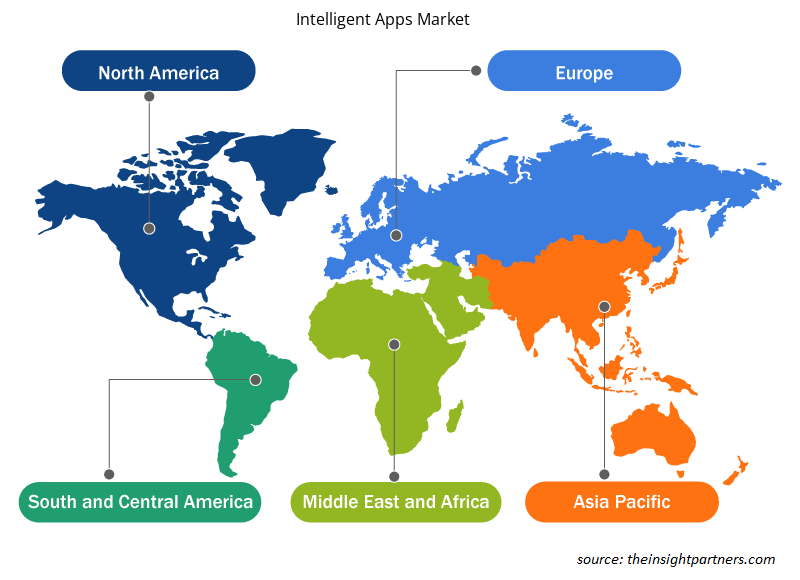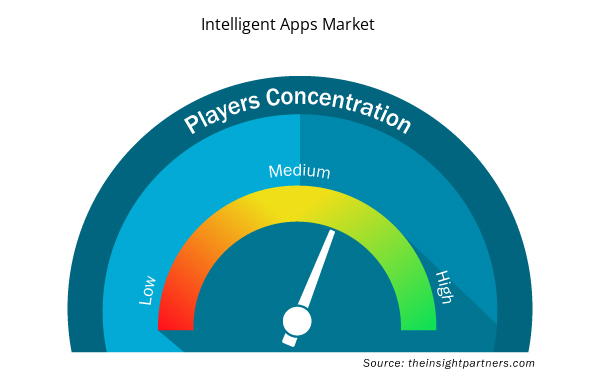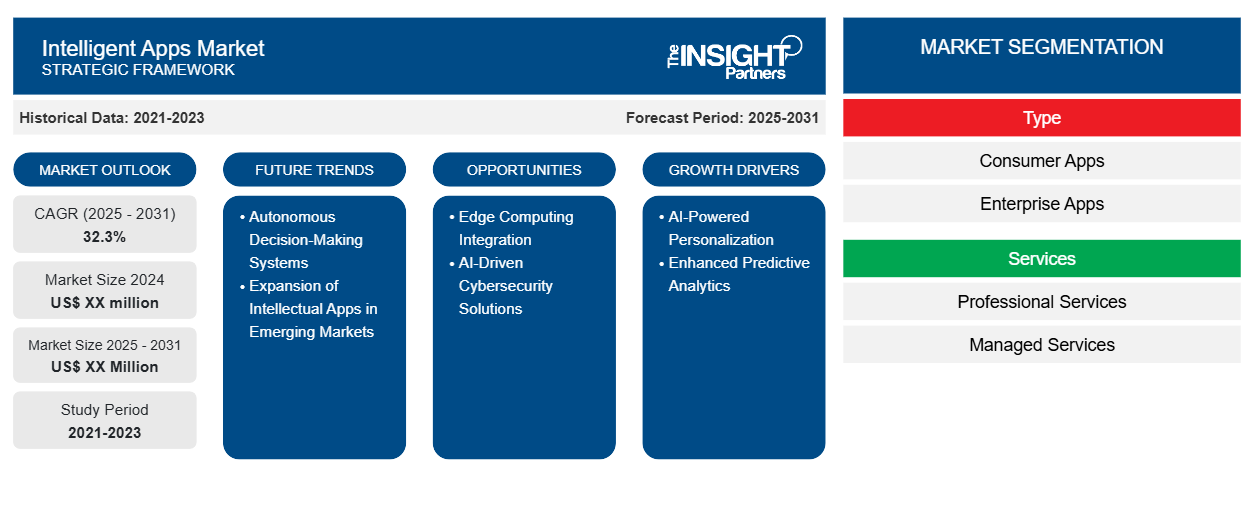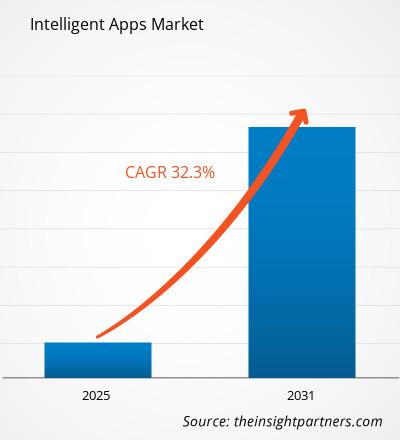Se espera que el mercado de aplicaciones inteligentes registre una CAGR del 32,3 % entre 2023 y 2031, con un tamaño de mercado que se expandirá de US$ XX millones en 2023 a US$ XX millones en 2031.
El informe está segmentado por tipo (aplicaciones para consumidores, aplicaciones empresariales); servicios (servicios profesionales, servicios gestionados); implementación (nube, en instalaciones locales); vertical (BFSI, telecomunicaciones, comercio minorista y electrónico, atención médica y ciencias biológicas, educación, medios y entretenimiento, viajes y hotelería, otros). El análisis global se desglosa aún más a nivel regional y por países principales. El informe ofrece el valor en USD para el análisis y los segmentos anteriores.
Propósito del Informe
El informe Intelligent Apps Market de The Insight Partners tiene como objetivo describir el panorama actual y el crecimiento futuro, los principales factores impulsores, los desafíos y las oportunidades. Esto proporcionará información a diversas partes interesadas del negocio, como:
- Proveedores/fabricantes de tecnología: Para comprender la dinámica cambiante del mercado y conocer las oportunidades potenciales de crecimiento, lo que les permitirá tomar decisiones estratégicas informadas.
- Inversionistas: Realizar un análisis exhaustivo de tendencias sobre la tasa de crecimiento del mercado, las proyecciones financieras del mercado y las oportunidades que existen en toda la cadena de valor.
- Órganos reguladores: Regular las políticas y vigilar las actividades del mercado con el objetivo de minimizar los abusos, preservar la confianza de los inversores y defender la integridad y estabilidad del mercado.
Segmentación del mercado de aplicaciones inteligentes
Tipo
- Aplicaciones para consumidores
- Aplicaciones empresariales
Servicios
- Servicios profesionales
- Servicios gestionados
Despliegue
- Nube
- En las instalaciones
Vertical
- BFSI
- Telecomunicaciones
- Venta minorista y comercio electrónico
- Salud y ciencias biológicas
- Educación
- Medios y entretenimiento
- Viajes y Hostelería
- Otros
Vertical
- BFSI
- Telecomunicaciones
- Venta minorista y comercio electrónico
- Salud y ciencias biológicas
- Educación
- Medios y entretenimiento
- Viajes y Hostelería
- Otros
Personalice este informe según sus necesidades
Obtendrá personalización en cualquier informe, sin cargo, incluidas partes de este informe o análisis a nivel de país, paquete de datos de Excel, así como también grandes ofertas y descuentos para empresas emergentes y universidades.
- Obtenga las principales tendencias clave del mercado de este informe.Esta muestra GRATUITA incluirá análisis de datos, desde tendencias del mercado hasta estimaciones y pronósticos.
Factores impulsores del crecimiento del mercado de aplicaciones inteligentes
- Personalización impulsada por IA: las organizaciones aprovechan cada vez más los algoritmos de aprendizaje automático para ofrecer experiencias de usuario hiperpersonalizadas en todas las aplicaciones. Al analizar el comportamiento, las preferencias y las interacciones históricas de los usuarios, las aplicaciones inteligentes pueden adaptar dinámicamente las interfaces, las recomendaciones y el contenido en tiempo real, lo que crea experiencias digitales más atractivas e intuitivas.
- Análisis predictivo mejorado: las aplicaciones inteligentes están integrando capacidades avanzadas de análisis predictivo que permiten a las empresas pronosticar tendencias, anticipar las necesidades de los clientes y tomar decisiones basadas en datos. Estas aplicaciones utilizan modelos sofisticados de aprendizaje automático para procesar conjuntos de datos complejos y brindar información útil que transforma los enfoques reactivos tradicionales en una planificación estratégica proactiva.
Tendencias futuras del mercado de aplicaciones inteligentes
- Sistemas de toma de decisiones autónoma: las aplicaciones inteligentes están evolucionando hacia capacidades de toma de decisiones más autónomas, donde los algoritmos de IA pueden analizar de forma independiente escenarios complejos, generar recomendaciones e incluso ejecutar acciones con una mínima intervención humana. Esta tendencia está revolucionando las industrias al permitir procesos de toma de decisiones más rápidos, más precisos y sensibles al contexto en varios dominios.
- Expansión de las aplicaciones intelectuales en los mercados emergentes: El crecimiento de los mercados emergentes presenta una oportunidad interesante para las aplicaciones intelectuales, en particular en regiones como Asia-Pacífico, América Latina y África, donde la innovación y la protección de la propiedad intelectual cobran cada vez más importancia. Muchas empresas de estas regiones están desarrollando nuevas tecnologías, productos y servicios y necesitan herramientas de gestión de la propiedad intelectual para proteger sus innovaciones. Las aplicaciones intelectuales pueden satisfacer las necesidades de las empresas de estos mercados ofreciendo soluciones localizadas que cumplan con las regulaciones regionales de propiedad intelectual, ayudando a las empresas de las economías emergentes a presentar patentes, registrar marcas y proteger su propiedad intelectual a nivel mundial. Se espera que esta tendencia impulse la demanda de aplicaciones intelectuales en estos mercados de rápido desarrollo.
Oportunidades de mercado para aplicaciones inteligentes
- Integración de Edge Computing: las aplicaciones inteligentes están explorando la integración perfecta con tecnologías de Edge Computing, lo que permite el procesamiento en tiempo real, una latencia reducida y una privacidad mejorada. Al distribuir las cargas de trabajo computacionales más cerca de las fuentes de datos, estas aplicaciones pueden ofrecer experiencias más rápidas y con mayor capacidad de respuesta, al tiempo que minimizan las limitaciones de ancho de banda y mejoran el rendimiento general del sistema.
- Soluciones de ciberseguridad basadas en inteligencia artificial: la creciente demanda de aplicaciones de ciberseguridad inteligentes presenta una importante oportunidad de mercado. Estas soluciones avanzadas aprovechan el aprendizaje automático y la inteligencia artificial para detectar anomalías, predecir posibles amenazas a la seguridad y desarrollar mecanismos de defensa adaptativos que pueden evolucionar más rápido que los sistemas de seguridad tradicionales basados en reglas.
Perspectivas regionales del mercado de aplicaciones inteligentes
Los analistas de Insight Partners explicaron en detalle las tendencias y los factores regionales que influyen en el mercado de aplicaciones inteligentes durante el período de pronóstico. Esta sección también analiza los segmentos y la geografía del mercado de aplicaciones inteligentes en América del Norte, Europa, Asia Pacífico, Oriente Medio y África, y América del Sur y Central.

- Obtenga datos regionales específicos para el mercado de aplicaciones inteligentes
Alcance del informe sobre el mercado de aplicaciones inteligentes
| Atributo del informe | Detalles |
|---|---|
| Tamaño del mercado en 2023 | XX millones de dólares estadounidenses |
| Tamaño del mercado en 2031 | US$ XX millones |
| Tasa de crecimiento anual compuesta (CAGR) global (2023-2031) | 32,3% |
| Datos históricos | 2021-2022 |
| Período de pronóstico | 2024-2031 |
| Segmentos cubiertos | Por tipo
|
| Regiones y países cubiertos | América del norte
|
| Líderes del mercado y perfiles de empresas clave |
|
Densidad de actores del mercado de aplicaciones inteligentes: comprensión de su impacto en la dinámica empresarial
El mercado de aplicaciones inteligentes está creciendo rápidamente, impulsado por la creciente demanda de los usuarios finales debido a factores como la evolución de las preferencias de los consumidores, los avances tecnológicos y una mayor conciencia de los beneficios del producto. A medida que aumenta la demanda, las empresas amplían sus ofertas, innovan para satisfacer las necesidades de los consumidores y aprovechan las tendencias emergentes, lo que impulsa aún más el crecimiento del mercado.
La densidad de actores del mercado se refiere a la distribución de las empresas o firmas que operan dentro de un mercado o industria en particular. Indica cuántos competidores (actores del mercado) están presentes en un espacio de mercado determinado en relación con su tamaño o valor total de mercado.
Las principales empresas que operan en el mercado de aplicaciones inteligentes son:
- IBM
- Compañía Apple Inc.
- Ayasdi AI LLC
- Código de producto: ML-001
Descargo de responsabilidad : Las empresas enumeradas anteriormente no están clasificadas en ningún orden particular.

- Obtenga una descripción general de los principales actores clave del mercado de aplicaciones inteligentes
Puntos de venta clave
- Cobertura integral: el informe cubre exhaustivamente el análisis de productos, servicios, tipos y usuarios finales del mercado de aplicaciones inteligentes, proporcionando un panorama holístico.
- Análisis de expertos: el informe se compila sobre la base de un profundo conocimiento de expertos y analistas de la industria.
- Información actualizada: El informe asegura relevancia comercial debido a su cobertura de información reciente y tendencias de datos.
- Opciones de personalización: este informe se puede personalizar para satisfacer los requisitos específicos del cliente y adaptarse adecuadamente a las estrategias comerciales.
Por lo tanto, el informe de investigación sobre el mercado de aplicaciones inteligentes puede ayudar a abrir camino para descifrar y comprender el escenario de la industria y las perspectivas de crecimiento. Si bien puede haber algunas preocupaciones válidas, los beneficios generales de este informe tienden a superar las desventajas.
- Historical Analysis (2 Years), Base Year, Forecast (7 Years) with CAGR
- PEST and SWOT Analysis
- Market Size Value / Volume - Global, Regional, Country
- Industry and Competitive Landscape
- Excel Dataset

Report Coverage
Revenue forecast, Company Analysis, Industry landscape, Growth factors, and Trends

Segment Covered
This text is related
to segments covered.

Regional Scope
North America, Europe, Asia Pacific, Middle East & Africa, South & Central America

Country Scope
This text is related
to country scope.
Frequently Asked Questions
Some of the customization options available based on the request are an additional 3-5 company profiles and country-specific analysis of 3-5 countries of your choice. Customizations are to be requested/discussed before making final order confirmation# as our team would review the same and check the feasibility
The report can be delivered in PDF/PPT format; we can also share excel dataset based on the request
Autonomous decision-making systems is anticipated to play a significant role in the global intelligent apps market in the coming years
The Intelligent Apps Market is estimated to witness a CAGR of 32.3% from 2023 to 2031
AI-powered personalization and enhanced predictive analytics are the major factors driving the intelligent apps market
Trends and growth analysis reports related to Technology, Media and Telecommunications : READ MORE..
1.IBM
2.Apple Inc.
3.Ayasdi AI LLC
4.BigML, Inc.
5.Google
6.H2O.ai
7.Hewlett Packard Enterprise Development LP
8.Microsoft
9.Oracle
10.SAP
The Insight Partners performs research in 4 major stages: Data Collection & Secondary Research, Primary Research, Data Analysis and Data Triangulation & Final Review.
- Data Collection and Secondary Research:
As a market research and consulting firm operating from a decade, we have published and advised several client across the globe. First step for any study will start with an assessment of currently available data and insights from existing reports. Further, historical and current market information is collected from Investor Presentations, Annual Reports, SEC Filings, etc., and other information related to company’s performance and market positioning are gathered from Paid Databases (Factiva, Hoovers, and Reuters) and various other publications available in public domain.
Several associations trade associates, technical forums, institutes, societies and organization are accessed to gain technical as well as market related insights through their publications such as research papers, blogs and press releases related to the studies are referred to get cues about the market. Further, white papers, journals, magazines, and other news articles published in last 3 years are scrutinized and analyzed to understand the current market trends.
- Primary Research:
The primarily interview analysis comprise of data obtained from industry participants interview and answers to survey questions gathered by in-house primary team.
For primary research, interviews are conducted with industry experts/CEOs/Marketing Managers/VPs/Subject Matter Experts from both demand and supply side to get a 360-degree view of the market. The primary team conducts several interviews based on the complexity of the markets to understand the various market trends and dynamics which makes research more credible and precise.
A typical research interview fulfils the following functions:
- Provides first-hand information on the market size, market trends, growth trends, competitive landscape, and outlook
- Validates and strengthens in-house secondary research findings
- Develops the analysis team’s expertise and market understanding
Primary research involves email interactions and telephone interviews for each market, category, segment, and sub-segment across geographies. The participants who typically take part in such a process include, but are not limited to:
- Industry participants: VPs, business development managers, market intelligence managers and national sales managers
- Outside experts: Valuation experts, research analysts and key opinion leaders specializing in the electronics and semiconductor industry.
Below is the breakup of our primary respondents by company, designation, and region:

Once we receive the confirmation from primary research sources or primary respondents, we finalize the base year market estimation and forecast the data as per the macroeconomic and microeconomic factors assessed during data collection.
- Data Analysis:
Once data is validated through both secondary as well as primary respondents, we finalize the market estimations by hypothesis formulation and factor analysis at regional and country level.
- Macro-Economic Factor Analysis:
We analyse macroeconomic indicators such the gross domestic product (GDP), increase in the demand for goods and services across industries, technological advancement, regional economic growth, governmental policies, the influence of COVID-19, PEST analysis, and other aspects. This analysis aids in setting benchmarks for various nations/regions and approximating market splits. Additionally, the general trend of the aforementioned components aid in determining the market's development possibilities.
- Country Level Data:
Various factors that are especially aligned to the country are taken into account to determine the market size for a certain area and country, including the presence of vendors, such as headquarters and offices, the country's GDP, demand patterns, and industry growth. To comprehend the market dynamics for the nation, a number of growth variables, inhibitors, application areas, and current market trends are researched. The aforementioned elements aid in determining the country's overall market's growth potential.
- Company Profile:
The “Table of Contents” is formulated by listing and analyzing more than 25 - 30 companies operating in the market ecosystem across geographies. However, we profile only 10 companies as a standard practice in our syndicate reports. These 10 companies comprise leading, emerging, and regional players. Nonetheless, our analysis is not restricted to the 10 listed companies, we also analyze other companies present in the market to develop a holistic view and understand the prevailing trends. The “Company Profiles” section in the report covers key facts, business description, products & services, financial information, SWOT analysis, and key developments. The financial information presented is extracted from the annual reports and official documents of the publicly listed companies. Upon collecting the information for the sections of respective companies, we verify them via various primary sources and then compile the data in respective company profiles. The company level information helps us in deriving the base number as well as in forecasting the market size.
- Developing Base Number:
Aggregation of sales statistics (2020-2022) and macro-economic factor, and other secondary and primary research insights are utilized to arrive at base number and related market shares for 2022. The data gaps are identified in this step and relevant market data is analyzed, collected from paid primary interviews or databases. On finalizing the base year market size, forecasts are developed on the basis of macro-economic, industry and market growth factors and company level analysis.
- Data Triangulation and Final Review:
The market findings and base year market size calculations are validated from supply as well as demand side. Demand side validations are based on macro-economic factor analysis and benchmarks for respective regions and countries. In case of supply side validations, revenues of major companies are estimated (in case not available) based on industry benchmark, approximate number of employees, product portfolio, and primary interviews revenues are gathered. Further revenue from target product/service segment is assessed to avoid overshooting of market statistics. In case of heavy deviations between supply and demand side values, all thes steps are repeated to achieve synchronization.
We follow an iterative model, wherein we share our research findings with Subject Matter Experts (SME’s) and Key Opinion Leaders (KOLs) until consensus view of the market is not formulated – this model negates any drastic deviation in the opinions of experts. Only validated and universally acceptable research findings are quoted in our reports.
We have important check points that we use to validate our research findings – which we call – data triangulation, where we validate the information, we generate from secondary sources with primary interviews and then we re-validate with our internal data bases and Subject matter experts. This comprehensive model enables us to deliver high quality, reliable data in shortest possible time.




 Get Free Sample For
Get Free Sample For